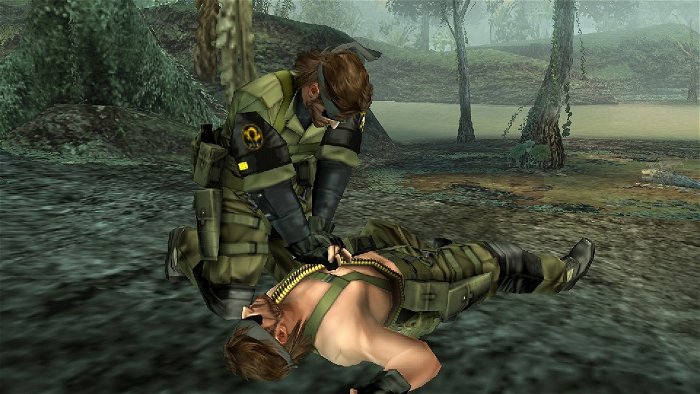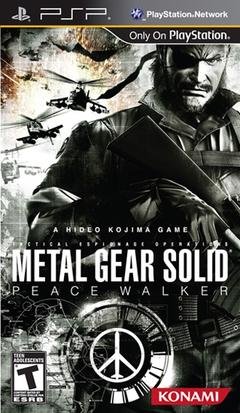When you make a game like Metal Gear Solid 4, you have to ask yourself, where do you go from here? Whether you liked the game or not, it was bold and big, taking all the ideas associated with the Metal Gear Solid series – its stealth gameplay, its long cutscenes, its convoluted story, its fetishization of machinery, its daunting level of detail – and pushing them to their limits. With Peace Walker, series creator Hideo Kojima decided to go in a different direction: the excesses of the series were largely stripped away, resulting in a more restrained, gameplay-rich, and overall tighter Metal Gear Solid experience in a decade.
It’s been ten years since the events of Metal Gear Solid 3 when a young Naked Snake killed his mentor to prevent nuclear war. It still haunts him. Peace Walker begins with Snake, disillusioned with the American military and forming his own private militia, Militaires Sans Frontière, being asked to take on a mission in Costa Rica. He refuses until he learns that his old mentor may be involved. Skeptical but still haunted by the memory of her death, Naked Snake takes his private army to Costa Rica.
“Peace Walker gives the player plenty of room to maneuver while keeping the sense of danger intact.”
The story is stripped down, told in raw, comic book-style cutscenes that eschew the realism and dense and confusing mythology for which the Metal Gear Solid series is infamous. This stripped-down feel carries over into the game and its mission structure. Again bucking the Metal Gear tradition, the game is not one continuous adventure but broken up into small missions perfect for the morning commute.

While some entries in the series have been too claustrophobic (Metal Gear Solid 2) or too open (Metal Gear Solid 3), Peace Walker gives the player plenty of room to maneuver while keeping the sense of danger intact. The jungle levels early in the game lend themselves easily to camouflage (either by you or your enemy), while later stages open up with multiple levels and angles of attack. If a mission is difficult, there’s usually another way around it; the game also allows you to rearrange your gear at the start of each mission, giving you even more options.
This, coupled with the decision to ditch the excruciatingly slow prone crawl, gives the game a brisk pace. It’s hardly a full-on action game, but it does alleviate some of the tedium that comes with meticulously analyzing patrol patterns. The controls take a bit of getting used to, but the game is accommodating, allowing for a different movement and camera scheme. It’s telling that there are brief flashes where the game becomes an action movie; the controls are smooth and manageable, rarely getting in the way. The close-quarters combat system, a confusing and unnecessary mess in Metal Gear Solid 3, is also much more manageable and versatile here.
“The game’s AI is quite advanced, flushing players with grenades and coordinating attacks.”
But this is still a Metal Gear Solid game, and stealth is an important element. After each mission you get a score based on how well you stayed hidden. The main reason for taking out enemies is to kidnap them via balloon for your own private militia. Ignoring the fact that this somehow works indoors, and that you’re hiring people who tried to kill you not five minutes before, it’s an engaging mechanic.

All of these kidnapped soldiers make up Outer Heaven, the metagame that is played between missions. Each soldier has stats, making the decision of where to put them pretty simple, but the challenge comes in managing long-term needs. Got a lot of sick or wounded soldiers? Maybe shuffling some grunts to the medical team is your best bet. Are you a few levels away from being able to research a new rocket launcher that can help in the next mission? Put some guys in R&D. Low morale? KP in the mess hall will fix that.
The game unfolds these elements gradually, never overwhelming the player with choices. Later in the game, you can take care of captured vehicles, send a strike team to conduct guerrilla attacks on neighboring countries, and even, in a sly bit of foreshadowing, build your own Metal Gear.
You can even play as a member of your team during some of the Extra Ops, a series of missions outside of the main storyline. Unlike the VR missions in other games in the series, these missions are more directly related to the game’s campaign. For example, there’s a blocked entrance in one part of the map. One of the Extra Ops is to C4 the blockage, making it accessible for future missions in the same area. Another has you defending the base from attack while Snake sneaks into an enemy base. They provide a breather between missions, giving you time to research and grab more soldiers in preparation for a particularly tough mission.

While all of these elements add up to the purest form of the Metal Gear Solid series, the best element is the co-op. Almost every mission in the game is playable with another player, some as many as 3. Having another gun by your side can be really useful, especially in the really difficult boss fights, but the developers have included several co-op friendly mechanics to enhance the experience. The infamous crate can now fit two people (an advancement in crate technology, as one character says).
Being in close proximity provides shared health, a move that discourages wandering too far. The more you play with someone, the higher your camaraderie rank, which leads to more bonuses and perks; the only superfluous element is the Command Command, which allows you to give in-game orders with potential bonuses, but it’s cumbersome to execute in the heat of battle, especially when all you can do is yell at the person next to you.
“Kojima and company have gone back to basics here, letting the player live the experience rather than just watch it.”
The deathmatch options are also quite extensive. The levels, as mentioned, allow for some great hide-and-seek gameplay, and while the game’s AI is quite advanced, flushing players with grenades and coordinating attacks, there’s nothing quite like playing against another person. Team Deathmatch is even better, allowing for complex planning. There’s no death more humiliating than being knocked unconscious only to be lifted by a giant balloon – a fate worse than death.
There’s an intense mission late in the game involving a large mining pit. Hiding behind cover, you’re tasked with taking down a small army armed with rocket launchers and sniper rifles. It’s a big, bold set piece, simple in concept but rich in variety and scope. Previous games in the series have been content to showcase big action spectacles, but Kojima and company have gone back to basics here, letting the player live the experience rather than just watch it.






